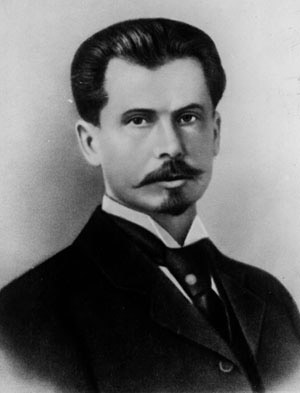- Sergei Winogradsky
Infobox Scientist
name = Sergei Winogradsky
box_width =
image_width = 150 px
caption =
birth_date =September 1 ,1856
birth_place =Kiev ,Russian Empire
death_date = death date and age|1953|2|25|1856|9|1
death_place =Brie-Comte-Robert ,France
residence =
citizenship =
nationality =
ethnicity =
field =Microbiology
work_institutions = Imperial Conservatoire of Music in St Petersburg (piano)University of Saint Petersburg University of Strasbourg Pasteur Institute
alma_mater =University of Saint Petersburg
doctoral_advisor =
doctoral_students =
known_for =Nitrogen cycle ChemoautotrophySulfur-oxidizing bacteria
author_abbrev_bot =
author_abbrev_zoo =
influences =Anton de Bary Nikolaj Menšutkin (chemistry)Nevskia Famintzin (botany)Martinus Beijerinck
influenced =Selman Waksman Martinus Beijerinck
prizes =Leeuwenhoek Medal (1935)
religion =
footnotes =Sergei Nikolaievich Winogradsky (or Vinogradskii; _ru. Сергей Николаевич Виноградский) (
September 1 ,1856 -February 25 ,1953 ) was aRussia nmicrobiologist ,ecologist and soil scientist who pioneered the cycle of life concept and discovered the biological process ofnitrification , the first known form of chemoautotrophy. Winogradsky was born inKiev , in what was then theRussian Empire , and entered the Imperial Conservatoire of Music in St Petersburg in 1875 to study piano.Thornton, H.G. 1953. [http://links.jstor.org/sici?sici=1479-571X%28195311%298%3A22%3C635%3ASNW1%3E2.0.CO%3B2-P&size=LARGE&origin=JSTOR-enlargePage "Sergei Nicholaevitch Winogradsky. 1856-1953."] "Obituary Notices of Fellows of the Royal Society". 8(22):635-644.] However, after two years of music training, he entered theUniversity of Saint Petersburg in 1877 to study chemistry under Nikolai Menshchutkin and botany underAndrei Sergeevich Famintzin . He took a diploma in 1881 and stayed at the University of St Petersburg to receive a degree of master of science in botany in 1884. In 1885, he began work at theUniversity of Strasbourg under the renowned botanistAnton de Bary ; Winogradsky became renowned for his work on sulfur bacteria. In 1888, he relocated toZurich , where he began investigation into the process of nitrification, identifying the genera "Nitrosomonas " and "Nitrosococcus ", which oxidizesammonium tonitrite , and "Nitrobacter ", which oxidizes nitrite tonitrate . He returned to St. Petersburg for the period 1891-1905 and there was chief of the division of general microbiology of the Institute of Experimental Medicine; during this period, he identified the obligate anaerobe "Clostridium pastorianum", which is capable of fixing atmospheric nitrogen. In 1901, he was elected honorary member of the Moscow Society of Natural Science and, in 1902, corresponding member of the French Academy of Sciences. He retired from active scientific work in 1905, dividing his time between his private estate and Switzerland. In 1922, he accepted an invitation to head the division of agricultural bacteriology at thePasteur Institute at an experimental station atBrie-Comte-Robert ,France , about 30 km fromParis . In this period, he worked on a number of topics, among them iron bacteria, nitrifying bacteria, nitrogen fixation by "Azotobacter ",cellulose -decomposing bacteria, and culture methods for soil microorganisms. Winogradsky retired from active life in 1940 and died in Brie-Comte-Robert.Winogradsky is best known for discovering chemoautotrophy, which soon became popularly known as chemosynthesis, the process by which organisms derive energy from a number of different
inorganic compounds and obtaincarbon in the form ofcarbon dioxide . Previously, it was believed that autotrophic organisms obtained their energy solely fromlight , not from reactions of inorganic chemical compounds. Winogradsky was one of the first researchers to attempt to understandmicroorganisms outside of the medical context, making him among the first students ofmicrobial ecology andenvironmental microbiology . TheWinogradsky column remains a fascinating display of chemoautotrophy and microbial ecology, demonstrated in microbiology lectures around the world.Further reading
* Waksman, S.A. 1946. "Sergei Nikolaevitch Winogradsky: The study of a great bacteriologist" "Soil Science" 62:197-226.
* Ackert, L. 2006. "The Role of Microbes in Agriculture: Sergei Vinogradskii’s Discovery and Investigation of Chemosynthesis, 1880-1910” "Journal of the History of Biology" 39:373-406.
* Ackert, L. 2006. "The 'Cycle of Life' in Ecology: Sergei Vinogradskii's Soil Microbiology, 1885-1940" "Journal of the History of Biology" 40:109-145.
* Ackert, L. 2004. "From the Thermodynamics of Life to Ecological Microbiology: Sergei Vinogradskii and the Cycle of Life, 1850-1950" (Ph.D. Dissertation, The Johns Hopkins University).ee also
*
Martinus Beijerinck
*Nitrogen fixation References
Persondata
NAME= Winogradsky, Sergei
ALTERNATIVE NAMES=
SHORT DESCRIPTION=Microbiology
DATE OF BIRTH= September 1, 1856
PLACE OF BIRTH=Kiev ,Russian Empire
DATE OF DEATH= February 25, 1953
PLACE OF DEATH=Brie-Comte-Robert ,France
Wikimedia Foundation. 2010.
